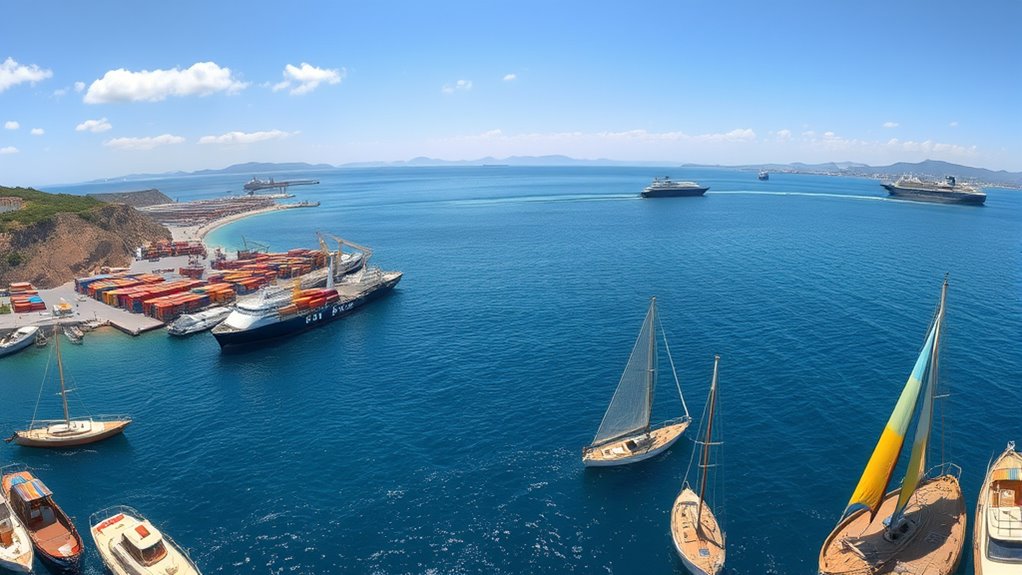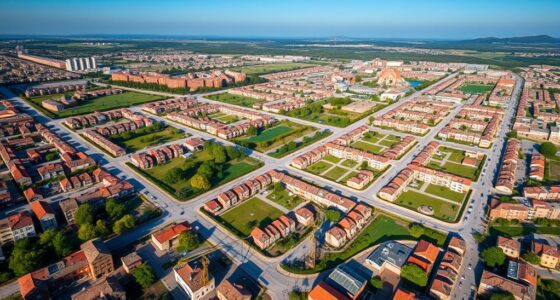Sardinia holds a key position in Mediterranean trade thanks to its strategic location connecting Europe, North Africa, and the Middle East. Its major ports, like Cagliari, handle millions of tons of cargo and connect with important regional and international routes. Ongoing investments in port infrastructure and sustainability projects boost its trade capacity and resilience. If you explore further, you’ll discover how Sardinia continues to shape regional commerce and adapt to future maritime challenges.
Key Takeaways
- Sardinia’s strategic location links key Mediterranean routes via its ports and the Strait of Bonifacio, facilitating regional and international trade.
- Major ports like Cagliari handle significant cargo volumes, supporting container, bulk, and passenger traffic across Europe, North Africa, and beyond.
- EU-funded infrastructure projects enhance Sardinia’s port efficiency, connectivity, and sustainability, boosting its role as a Mediterranean trade hub.
- Sardinia maintains vital trade relationships with North Africa, Europe, North America, and the Middle East, supporting diverse sectors like industry and tourism.
- Ongoing modernization and maritime planning efforts aim to strengthen Sardinia’s trade capacity while protecting environmental and biodiversity interests.
Sardinia’s Strategic Position in Mediterranean Maritime Routes
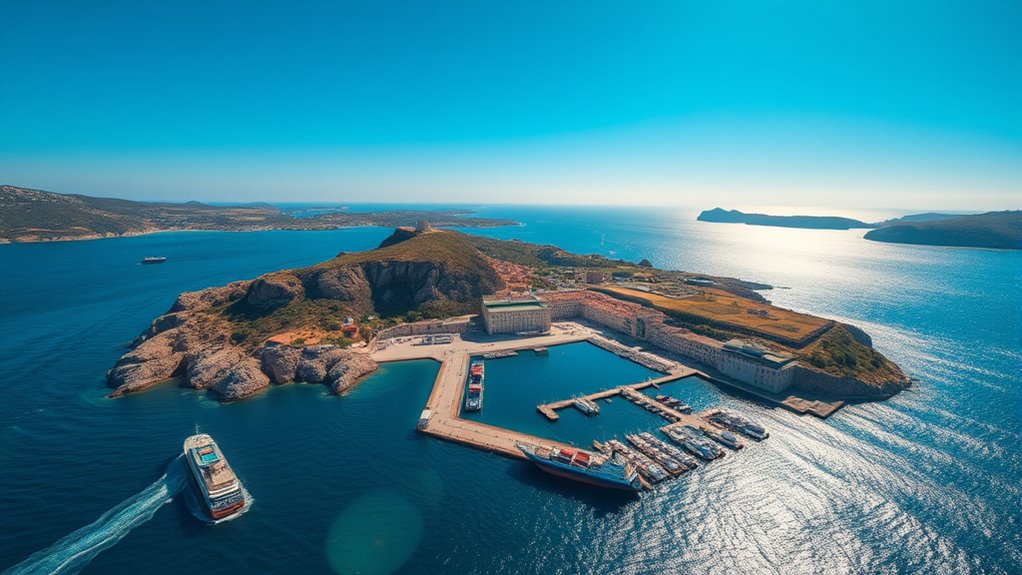
Sardinia’s central location in the Mediterranean makes it a essential hub for maritime trade and navigation. Sitting between Corsica, Italy, Sicily, Tunisia, and the Balearic Islands, it connects critical landmasses and sea routes. Positioned between the Tyrrhenian Sea and the Sea of Sardinia, it offers direct access to key navigation lanes. The Strait of Bonifacio, north of the island, acts as a pivotal passage between western and central Mediterranean routes. Its coastline features natural deep bays and inlets, providing sheltered anchorage and easy access for vessels. With coordinates around 38° 51′ to 41° 18′ N, and 8° 8′ to 9° 50′ E, Sardinia sits at an advantageous nexus point. This prime location has made it a strategic maritime junction for over 2,500 years, shaping regional trade and navigation. Its historical significance has further cemented its role as a vital maritime crossroads in the Mediterranean. Additionally, Sardinia’s maritime infrastructure continues to evolve, supporting modern trade and economic growth in the region.
Key Ports and Their Role in Regional Commerce
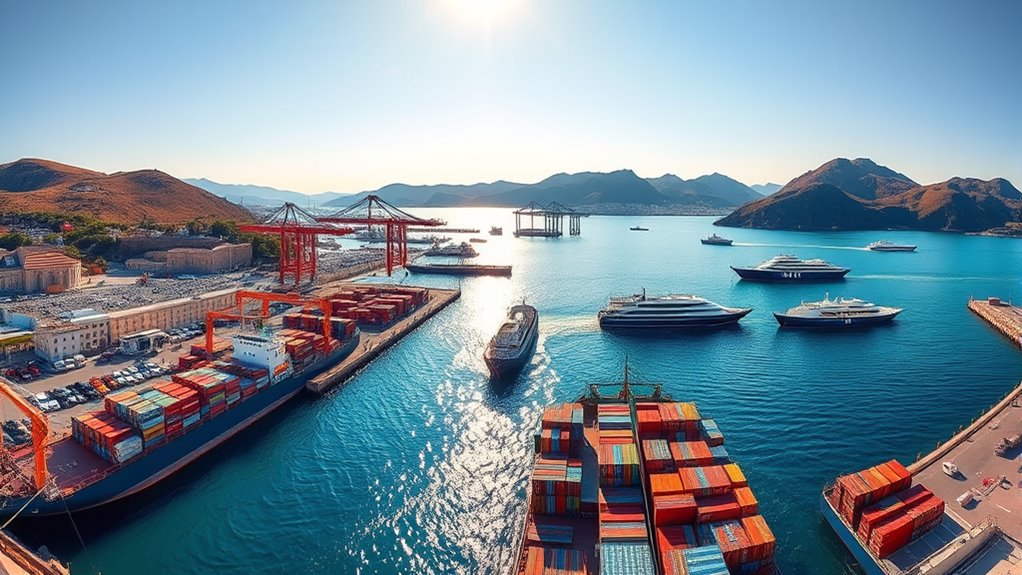
Among Sardinia’s ports, Cagliari stands out as an essential hub for regional commerce, handling around 50 million tonnes of cargo and one million TEUs annually. With over 29 berths and more than 50 wharfs, it supports approximately 8,000 vessel dockings each year, offering a range of services including container handling, bulk cargo, ro-ro, transshipment, and passenger traffic. Its strategic location near the Gibraltar-Suez route strengthens its role in Mediterranean trade. Cagliari also connects to key ports like Valencia, Civitavecchia, and Palermo via ferry freight, boosting regional integration. Other ports like Sarroch, Arbatax, Porto Torres, and Olbia complement Cagliari’s activity, ensuring Sardinia’s ports remain vital nodes for import, export, and regional commerce, contributing considerably to the island’s economic vitality.
Infrastructure Modernization and Sustainable Growth Initiatives
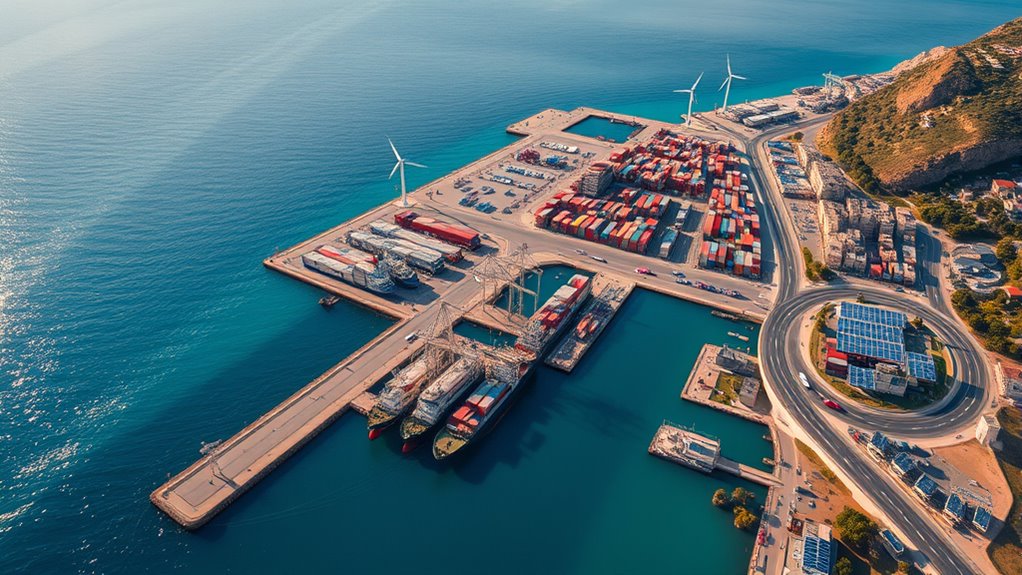
To support sustainable growth and enhance its role in Mediterranean trade, Sardinia is actively modernizing its infrastructure through EU-funded projects. The region allocated €210 million from the 2021–27 EU Cohesion Fund to upgrade ports, roads, and water systems, boosting transport efficiency and resilience. Investments focus on mitigating hydrogeological risks to protect critical infrastructure, supporting regional economic development. Construction on the SaCoI3 200kV electrical interconnection linking Sardinia, Corsica, and Tuscany is underway, ensuring energy stability and facilitating renewable integration. Legislation designates areas for renewable energy projects, backed by a €678 million fund for solar and storage systems, reducing fossil fuel dependence. Additionally, €35 million targets urban regeneration, revitalizing trade zones with eco-friendly infrastructure and green spaces, fostering sustainable growth and competitiveness. Modern infrastructure development is essential for bolstering regional trade networks and attracting investment.
Connectivity and Trade Flows Between Sardinia and the Mediterranean Basin
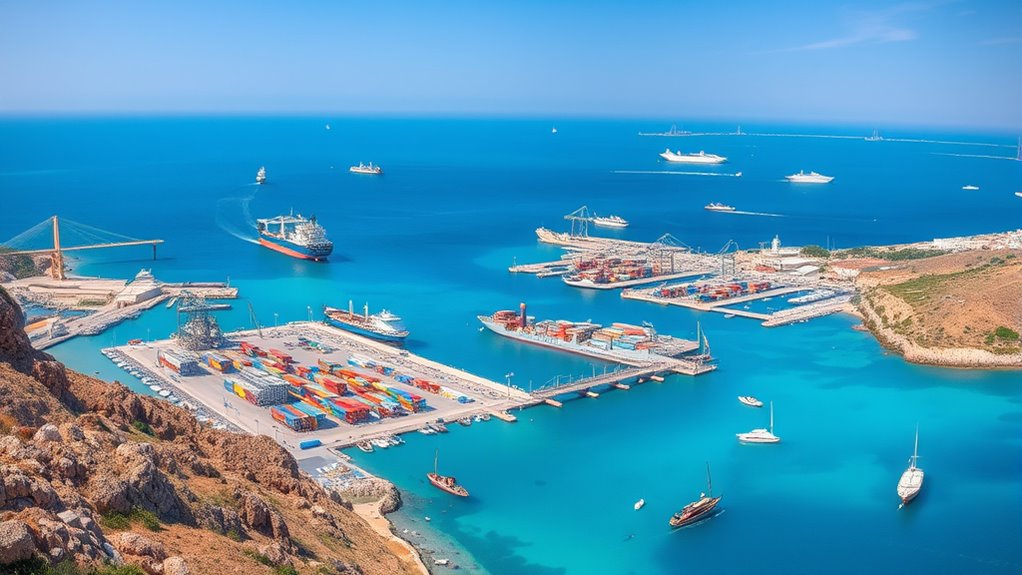
Despite recent challenges, Sardinia remains a key player in Mediterranean trade, leveraging its strategic port locations and transportation networks to connect with Europe, North Africa, and beyond. Its ports facilitate essential trade flows, especially with North Africa and other Mediterranean regions. While exports from Sardinia dipped 9.7% in early 2025, its ports still serve as crucial hubs for international trade. The island’s connectivity is strengthened through maritime and air links, supporting sectors like tourism, services, and industry. Trade flows are increasingly directed toward markets like the U.S. and the Middle East, reflecting Sardinia’s expanding global reach. The following table highlights Sardinia’s trade relationships and infrastructure:
| Trade Partner | Main Export Sectors | Transport Mode |
|---|---|---|
| North Africa | Services, fisheries | Ports, ferries |
| U.S. | Industry, tourism | Air, maritime |
| Middle East | Agriculture, services | Ports, logistics |
| Europe | All sectors | Ports, road networks |
The connectivity of Sardinia’s ports and transportation networks plays a crucial role in maintaining its position in Mediterranean trade, especially as global trade patterns evolve. Moreover, investments in infrastructure are expected to bolster Sardinia’s capacity to adapt to changing market demands and further enhance its trade capabilities.
Challenges and Future Directions for Sardinia’s Maritime Economy
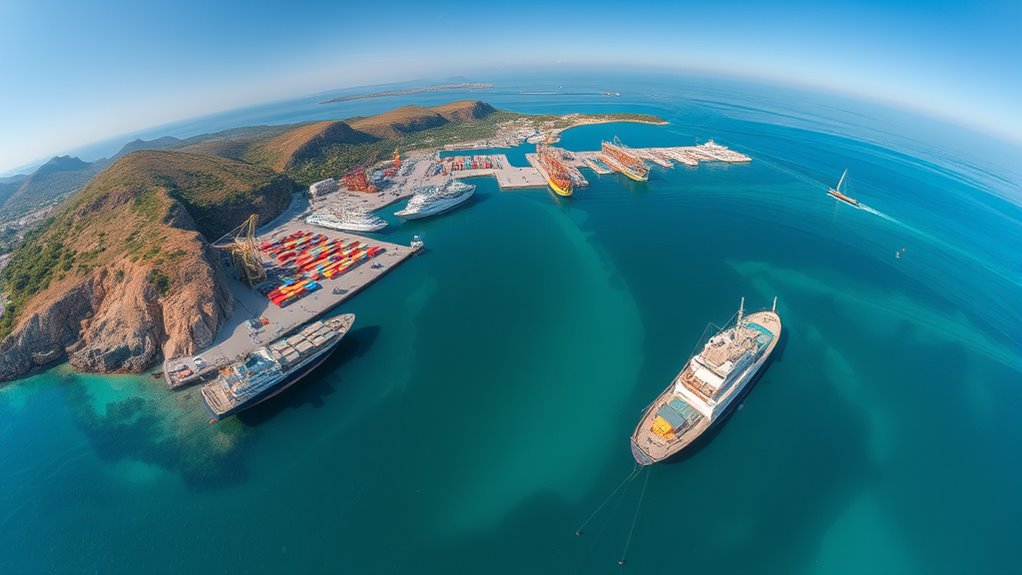
Sardinia faces significant challenges in advancing its maritime economy, primarily due to regulatory complexities, infrastructure limitations, and environmental concerns. The region is working on a maritime spatial planning strategy aligned with EU Blue Economy directives, aiming for a 10-year outlook that balances sustainability, renewable energy, and ecosystem health. Coordination among regional authorities, scientific bodies, and international institutions is key to effective policy implementation, but compliance with maritime regulations remains a hurdle. Infrastructure upgrades are needed to handle growing freight and passenger traffic, while port modernization faces environmental scrutiny. Additionally, protecting marine biodiversity amid climate change impacts and promoting renewable energy sources are essential. Focusing on industry trends can help Sardinia adapt to evolving market demands and technological advancements. Addressing these challenges will shape Sardinia’s maritime future, ensuring economic growth aligns with environmental preservation.
Frequently Asked Questions
How Does Sardinia Attract International Shipping Companies and Investors?
You see that Sardinia attracts international shipping companies and investors through its strategic location, acting as a crucial maritime hub connecting Europe, North Africa, and the Middle East. Its modern port facilities, efficient transport infrastructure, and access to European funding make it appealing. Plus, regional incentives like tax breaks and public-private partnerships create a favorable environment for growth, innovation, and sustainable development, making Sardinia an ideal place for trade and investment opportunities.
What Specific Environmental Policies Are Implemented at Sardinian Ports?
You might think Sardinian ports are just scenic spots for cruise ships, but they’re actually eco-warriors in disguise. They follow strict policies like the ‘Suitable Areas Decree’ for renewable energy, promote circular economy practices, and support marine restoration projects. These efforts aim to balance port activity with environmental preservation, ensuring Sardinia’s natural beauty isn’t just a pretty face but a thriving ecosystem. Talk about portly environmentalism with a Mediterranean flair!
How Does Sardinia’s Port Infrastructure Support Tourism Growth?
You see that Sardinia’s port infrastructure is designed to support tourism growth by offering modern facilities that handle large cruise ships and passenger volumes efficiently. Ports like Olbia and Cagliari connect seamlessly to airports and local transport, making it easy for tourists to explore. Upgraded terminals and sustainable practices, such as shore power, guarantee ports can accommodate increasing visitor numbers while minimizing environmental impacts.
What Are the Main Technological Innovations Adopted in Sardinian Ports?
They say “the proof of the pudding is in the eating,” and Sardinian ports prove their innovation through cutting-edge tech. You’ll see advanced port management systems, automated cranes, and smart passenger terminals with biometric check-ins. They’re embracing green energy, digital data exchange, and eco-friendly materials. These innovations boost efficiency, sustainability, and passenger comfort, ensuring Sardinia stays competitive and forward-looking in Mediterranean maritime trade and logistics.
How Does Sardinia Plan to Handle Future Trade Disruptions?
You’re wondering how Sardinia plans to handle future trade disruptions. Sardinia invests heavily in upgrading infrastructure, including ports and digital systems, to boost resilience. It diversifies its economy through sectors like tourism and niche manufacturing, reducing reliance on traditional exports. The region also collaborates with Italy and global markets, monitors trade flows, and adopts flexible strategies to adapt quickly to geopolitical or economic shocks, ensuring trade continuity and stability.
Conclusion
So, next time you think Sardinia’s just a pretty island, remember it’s a busy Mediterranean hub, juggling ships and trade like a seasoned juggler. With its ports buzzing and plans for greener growth, it’s clearly aiming to stay relevant. Just don’t be surprised if Sardinia suddenly becomes the Mediterranean’s secret trade superstar—after all, who needs Hollywood when you’ve got maritime magic, right? Stay tuned, the island’s got plans, and they’re not just sailing away!
